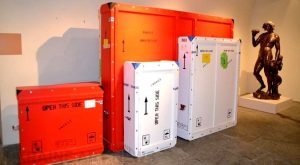03.08.2018
Large-scale retrospective exhibitions devoted to creativity from prominent old masters of world art to well-known representatives of the present – it is always a laborious work and a great responsibility of professionals involved in logistics.
How to deliver such masterpieces to your destination? What general nuances should be taken into account when transporting such cargoes? And how much does it cost, on average, to organize a grand artistic exposition? These and other data were provided to one of the European publications by the expert of the insurance company Uniqua Peter Aybel.
According to her, holding an exhibition of masterpieces of world art can cost more than the cost of its exhibits. One insurance of such an exposure can cost from 1.5 to 2 billion euros. As a result, the full protection of works of art from damage in the process of transportation, as well as from fires, floods and vandalism is ensured. If you add packaging costs, security guards, expert examination and transport, then as a shame, it costs an additional from 35 to 40 million euros.
Also, Ms. Aybel noticed that if a piece of art costs more than 100 million euros, it is only transported alone, no other paintings or sculptures in a specially equipped truck is prohibited. Such requirements may cost even more substantial money. Transportation by rail and water is also strictly prohibited. For intercontinental transportation, aircraft usually use aircraft, but loading some expensive art objects in one liner is also strictly prohibited because in case of possible air crashes there is a threat of destruction of all cargo. There are also such exhibits, which are strictly prohibited. They include, for example, engraved wood engravings of the Dutch painters of the Bruegel dynasty.
Each exhibit, which is intended for transportation, requires a strict individual approach from the representatives of logistics. The team of professionals jointly decides and takes into account all the nuances in which conditions and how the transfer process will take place. Each picture is placed in a special sealed packaging, which provides a permanent microclimate and protects the canvas from mechanical damage and the penetration of harmful microorganisms. All special vehicles must be equipped with special belts, pneumatic suspension and climate control. And huge and massive exhibits, such as sculptures transported in containers using air cushion.
After the exhibits arrived at their destination they are not immediately unpacked but give them the opportunity to “acclimatize” at least within one day. And only after, in the presence of the members of the special commission, who fix the whole process, the exhibits are released from the package and delivered to the exposition with great caution.
